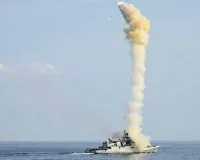Earth observation mission could not be accomplished due to 3rd stage pressure issue: ISRO chief
Earth observation mission

ISRO's 101st mission from here, an earth observation satellite onboard the agency's trusted PSLV rocket, could not be accomplished on Sunday following a
ISRO's 101st mission from here, an earth observation satellite onboard the agency's trusted PSLV rocket, could not be accomplished on Sunday following a pressure issue in the third stage of the launch vehicle, the space agency said.
Although the Polar Satellite Launch Vehicle (PSLV) made a textbook lift-off at the prefixed time of 5.59 am, the mission objectives, however, could not be achieved.
"Today we targeted the 101st launch from Sriharikota, the PSLV-C61 EOS-09 mission. The PSLV is a four-stage vehicle and up to the second stage, the performance was normal. The third stage motor started perfectly but during the functioning of the third stage we are seeing an observation and the mission could not be accomplished," Narayanan said.
The third stage is a solid motor system.
"...and the motor pressure--there was a fall in the chamber pressure of the motor case and the mission could not be accomplished. We are studying the entire performance, we shall come back at the earliest," Narayanan said post the unsuccessful launch.
The outcome of Sunday's launch would have come as a surprise to many, since PSLV has emerged to be the most reliable launch vehicle of ISRO.
Post lift-off, even till the second stage separation from the four-stage rocket, it was announced at the Mission Control Centre that they were being tracked by other centres of ISRO located in various parts of the country.
According to the data shared by the Indian Space Research Organisation (ISRO), the PS1 (first stage) separation was scheduled for 111.64 seconds after lift-off, but it was achieved at 110 seconds.
Further, the second stage ignition of the rocket was targeted to be achieved at 111.84 seconds, but the process occurred at 110.2 seconds leaving a marginal difference.
Similarly, the PS2 (second stage) separation was targeted at 264.34 seconds but it took place at 261.8 seconds.
Although things were proceeding on expected lines, as understood by the regular announcements by the scientists over the progress of the mission, it was after reaching the third stage that a glitch surfaced.
Meanwhile, a retired ISRO official, when asked about about the fate of the rocket after facing such an issue, said that it would have fallen into the sea as the issue cropped up at an altitude of about 450 km.
EOS-09 is a repeat satellite similar to EOS-04 launched in 2022 that has been designed with the mission objective to ensure remote sensing data for the user community engaged in operational applications and to improve the frequency of observation.
The mission's payload, a Synthetic Aperture Radar (SAR) which is inside the satellite, is capable of providing images for various earth observation applications under all-weather conditions, day and night.
This all-weather, round-the-clock imaging is vital for applications ranging from agriculture and forestry monitoring to disaster management, urban planning and national security.
The mission was aimed to be a debris-free one.
According to scientists, a sufficient amount of the fuel had been reserved for de-orbiting the satellite after its effective mission life by lowering it to an orbit that ensures its decay within two years, towards ensuring a debris-free mission.









